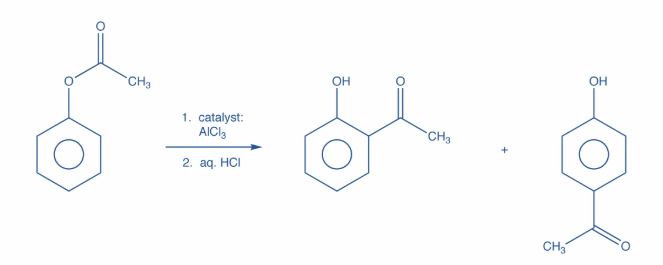
Answer
98.4k+ views
Hint: Phenyl ethanoate is basically the ester of phenol and acetic acid. It can further be produced by decarboxylation of aspirin or by reacting phenol with acetyl chloride or acetic anhydride. Moreover, aluminium chloride is used as a Lewis acid catalyst for a variety of reactions.
Complete step by step answer:
Ester is basically a chemical compound that is derived from an organic or inorganic acid in which hydroxyl group is replaced by an alkyl group. Moreover, esters are a group of chemical compounds which are formed by bonding of an alcohol group with a group of organic acids by losing water molecules.
Now, the products obtained when phenyl ethanoate reacts in presence of Anh. $AlC{l_3}$are o-hydroxy acetophenone and p-hyroxy acetophenone. This is known as Fries Rearrangement. Further, it is an organic rearrangement reaction in which an aryl ester is transformed into a hydroxyl aryl ketone with the help of a Lewis acid catalyst and an aqueous acid.
Moreover, this rearrangement is ortho and para selective i.e. the acyl group attaches itself at the ortho or para positions of the aryl ring. The reaction is as shown:

Hence, option B is correct.
Note: There are few limitations of this reaction. Owing to its relatively harsh reaction conditions, only esters with relatively stable acyl components can be used in this reaction. Moreover, the presence of deactivating or meta-directing groups on the aromatic ring results in low yields.
Complete step by step answer:
Ester is basically a chemical compound that is derived from an organic or inorganic acid in which hydroxyl group is replaced by an alkyl group. Moreover, esters are a group of chemical compounds which are formed by bonding of an alcohol group with a group of organic acids by losing water molecules.
Now, the products obtained when phenyl ethanoate reacts in presence of Anh. $AlC{l_3}$are o-hydroxy acetophenone and p-hyroxy acetophenone. This is known as Fries Rearrangement. Further, it is an organic rearrangement reaction in which an aryl ester is transformed into a hydroxyl aryl ketone with the help of a Lewis acid catalyst and an aqueous acid.
Moreover, this rearrangement is ortho and para selective i.e. the acyl group attaches itself at the ortho or para positions of the aryl ring. The reaction is as shown:

Hence, option B is correct.
Note: There are few limitations of this reaction. Owing to its relatively harsh reaction conditions, only esters with relatively stable acyl components can be used in this reaction. Moreover, the presence of deactivating or meta-directing groups on the aromatic ring results in low yields.
Recently Updated Pages
Write a composition in approximately 450 500 words class 10 english JEE_Main

Arrange the sentences P Q R between S1 and S5 such class 10 english JEE_Main

Write an article on the need and importance of sports class 10 english JEE_Main

Name the scale on which the destructive energy of an class 11 physics JEE_Main

Choose the exact meaning of the given idiomphrase The class 9 english JEE_Main

Choose the one which best expresses the meaning of class 9 english JEE_Main




